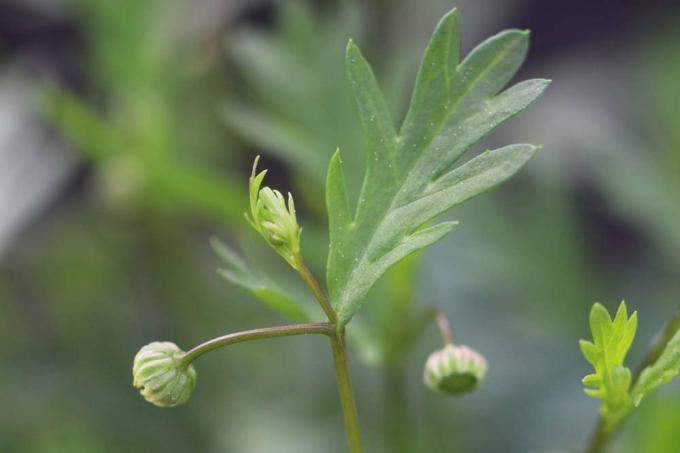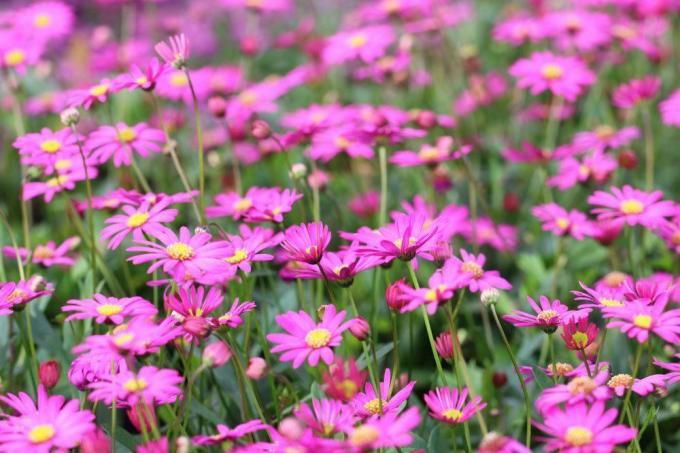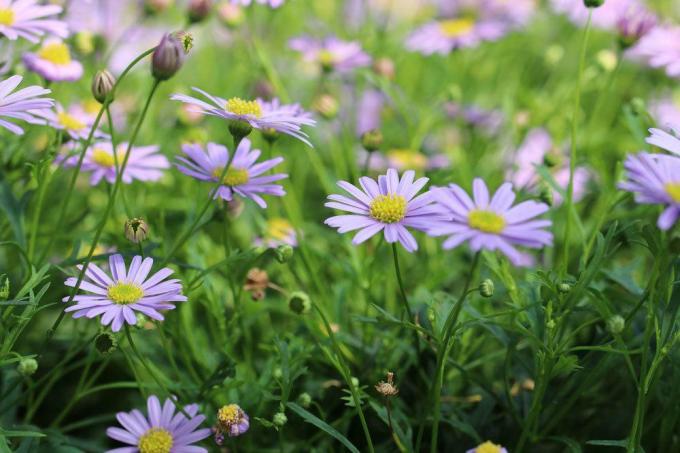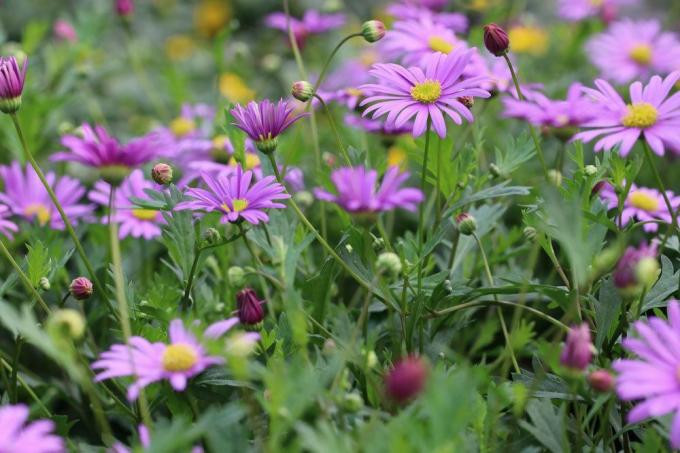
table of contents
- care
- Location
- Substrate
- Nutrient supply
- sowing
- plants
- to water
- Cut
- Overwinter
- Diseases
Profile and care information open +conclude -
- Flower color
- pink, purple, blue
- Location
- Partial shade, sunny
- Heyday
- May, June, July, August, September, October
- Growth habit
- upright, spreading, bushy, perennial
- height
- up to 50 centimeters high
- Soil type
- sandy, loamy, gritty
- Soil moisture
- moderately dry, fresh
- PH value
- neutral
- Limescale tolerance
- Calcium tolerant
- humus
- rich in humus
- Poisonous
- no
- Plant families
- Asteraceae
- Plant species
- Bedding plants, potted plants
- Garden style
- Flower garden, pot garden
Blue daisy is a permanent bloomer, which is very popular on the balcony and in the garden due to its distinctive flowers. The robust daisy has nothing in common with the domestic daisy. Only the shape of the flower is reminiscent of the well-known, white and yellow meadow flowers from our childhood. The cultivation of the beautiful ornamental plants is simple, specialist knowledge or a green thumb is not necessary. Brachyscome iberidifolia forgives many mistakes in care and regenerates quickly due to the strong growth.
care
The compact growing blue daisy is an herbaceous immigrant. The wild form of the plant originally comes from Australia, it was not until the 1980s that cultivated forms of the daisy family were commercially available as ornamental plants. Brachyscome iberidifolia got its trivial name because of the unmistakable resemblance to the domestic daisy. From a botanical point of view, however, blue daisies have little in common with small ornamental plants.

Location
The optimal location
The exotic plant can be used in many ways in the garden. Combine, for example, differently colored blooming varieties and create a visual eye-catcher in the rock garden. The compact growing perennials with their spherical growth are particularly suitable as foreground planting. The bushy perennial can also be grown on the terrace and balcony. Here she comes in Hanging baskets show off well.
- the location should be warm
- Protect blue daisies from drafts
- a light place in penumbra is tolerated
Regardless of whether the Australian ornamental plant is grown in pots or permanently outdoors: The perennial needs a lot of light to develop its distinctive, long-lasting bloom. The plant can cope with a few hours of sunshine a day. Avoid shady places. Blue daisies take care of these and are susceptible to diseases and pests.
Substrate
The plants with the fascinating flowers are undemanding and are usually sold as annual perennials. With the right care, it is possible to enjoy the flowers of the plants for many years. In the field, a humus-rich, well-drained and slightly sandy soil is advantageous.
Blue daisies are sensitive to highly compacted soil. Regular mulching can help. Loosen the substrate so that water and oxygen can get to the roots of the plants and sticky soil does not hinder the growth of the plants.
Alternatively, you can use small pebbles. The material is fine and does not hinder you in the maintenance of the garden in any way. At the same time, the stones permanently ensure that the soil does not compact into a hard mass. Brachyscome iberidifolia in the tub places similar conditions on the substrate.

Nutrient supply
Supply of nutrients
The blue daisies are popular, among other things, because of their long-lasting bloom. In order to be able to present its distinctive splendor from May to October, the ornamental plant needs a lot of minerals. If the plant is grown as an annual perennial in a bed, you should work a large amount of semi-ripe compost into the soil before planting.
This provides the perennials with enough nutrients for 6 to 8 weeks. Then you can apply organic fertilizers, such as horn shavings, around the plants. Another possibility is the use of long-term resp. Liquid fertilizer.
- liquid fertilizer is administered via the irrigation water
- follow the information on the package instructions
- in winter the supply of nutrients should rest
You should avoid compost and other organic material with plants in the bucket. The microorganisms necessary for decomposition are only partially present in the pot. Coffee grounds and the like are not broken down sufficiently and mold growth occurs. This can have a harmful effect on the daisy family.
An over or An oversupply of fertilizer is noticeable in Brachyscome iberidifolia in the form of pale leaves and the loss of flowers. If necessary, react quickly to protect the plants from vegetation. Fertilize with liquid nutrients or treat the plants to a fresh, lean substrate.
Severe leaf lightening can also be due to an iron deficiency. Every now and then use a special iron fertilizer that supplies the plants with the important mineral. This can be used preventively.

sowing
Blue daisies have few maintenance requirements. This is evident not only in the cultivation, but also in the cultivation of the popular ornamental plant. Warm temperatures, a moist substrate, and sunlight are the only factors necessary for successful germination. The sowing of the seeds in the bed is just as successful as the cultivation in the planter.
- prepare the bed in spring
- Remove dead plant remains and old roots
- Stake out the area
- To draw furrows
- Spread seeds over a large area
- pour carefully
When sowing, it is sufficient to distribute the seeds of Brachyscome iberidifolia generously in the bed. The daisy family belong to the light germinating plants. Sunlight breaks the germination inhibition of the seeds and stimulates them to grow. To protect against wind erosion, you can gently press the fine grains into place. The substrate must not dry out.
Growing in a flower box
The blue daisy needs warmth. Temperatures between 15 ° to 20 ° degrees are ideal for germination to begin. The development of Australian plants is delayed in the field. It works faster with sowing in the bucket. This can be done on the window sill at home as early as the end of February.
You need:
- poor substrate
- a shallow vessel
- Water atomizer
Brachyscome iberidifolia germinable seeds should be bought from nurseries. It is rare for blue daisies to produce germinable seeds in sufficient quantities. The reason: In order to promote permanent bloom, you have to cut wilted flowers regularly. Prepare the growing container and sprinkle the fine seeds over it.
The substrate is moistened with the water sprayer. Keep the soil evenly moist. Drought affects the older plants, with seedlings it can lead to death. It can take 10 to 14 days for the first shoot tips to appear. A bright place on the warm window sill is ideal as a location. Shield the vessel from direct sunlight.
The germination of brachyscome can be accelerated by temporarily increasing the air humidity. Cover the jar with a transparent film. The water in the substrate cannot evaporate and creates a climate similar to that in a greenhouse. To prevent mold and rot on the potting soil, the film must be removed for a few hours every day. As soon as the individual plants have reached a height of about 8 to 10 cm, you should prick out the young perennials.

plants
The delicate ornamental plants with the blue or purple flowers are sensitive to cold and frost. Blue daisies can only cope with temperatures below 6 ° C to a limited extent. A good reason to start planting in the bed or to wait in the hanging basket on the balcony until after the ice saints.
Prepare the bed:
- the planting hole should be twice the size of the Brachyscome root ball
- mix the substrate with humus, sand and pebbles
- Spread a few handfuls of compost in the planting hole
- Insert the plant up to the upper root neck
- Fill the cavity with soil and press it down
- pour vigorously
If you combine several specimens of the blue daisy with each other, you should ensure a minimum distance of about 30 cm. When planting in pots, drainage on the bottom of the container makes maintenance easier. For this, an approx. A 3 to 5 cm thick layer of lava chippings, pebbles or potsherds is laid out. The roots of the perennials must not come into direct contact with this material. This inhibits the growth of the perennials. A 6 cm high layer of substrate serves as a buffer.
Plants grown on a warm window sill often react with leaf discoloration to the influence of direct sunlight. These burns no longer regenerate. With a little preparation you can protect your plants from this: only expose the perennials to sunlight for a short time in the first few days. At lunchtime, it is advisable to shade the daisies with a parasol.
to water
Pour properly
When you think of Australia, you inevitably have the image of a dry and desert-like landscape in mind. The continent has more to offer, however, and not every plant there can cope with a prolonged drought. This is impressively demonstrated by Brachyscome iberidifolia. The delicate beauty with the deciduous leaves needs a moist substrate.

The following tips have proven useful when pouring:
- regularly check the moisture of the soil
- is poured on the front or afternoon
- the root ball must not dry out during the main growing season
- less is more, but pour more often
The exotic plant can only cope with lime to a limited extent. Too high a content in the soil or Watering water clogs the trachea of the plants and reduces the absorption of moisture and nutrients. Make use of stale rainwater for the aster family. This can be easily collected in containers in the garden and is suitable for watering almost all types of plants. Blue daisies react to a lack of water by stopping growth and wilting flowers.
Waterlogging can also be dangerous for the plant. Standing water in the bed or The cachepot creates a breeding ground for mushrooms. These pathogens are responsible for the root rot, feared by many gardeners. Prevent the disease and avoid waterlogging. In flower beds, the added gravel acts like a drainage. In the case of potted plants, this task is performed by porous, inorganic material on the bottom of the container.
An important note for watering the permanent bloomers: The water should be added slowly. Avoid watering directly over the flowers and leaves of the plants.
Cut
If blue daisies are cultivated as an annual perennial, you can do without pruning the up to 30 cm long shoots.
- wilted flowers with a pair of scissors or remove it with your fingernail
- Cut dead plant parts
- Shorten perennial plants sharply in spring
Brachyscome iberidifolia is not toxic to humans. Nevertheless, clean the tool you are using before and after work. This measure is important to minimize the potential risk of spreading germs and harmful insects on other plants in the garden.
Overwinter
The onset of the first frost usually means the death of the popular perennial bloomer. You can also overwinter the plant with little effort. This means that you do not have to buy or buy the plants every year. sowing. The perennial variety Brachyscome multifida has especially proven itself for this. Blue daisies should leave their place in the garden as soon as the temperature drops into the single-digit range and the risk of frost increases.

- the room for wintering should be bright and cool
- Temperatures between 5 ° to 10 ° C are ideal
- there is only sparse pouring
- avoid proximity to heat sources
- Protect plants from drafts
Brachyscome iberidifolia or Brachyscome multifida must not be fertilized in the cold season. The supply of nutrients stimulates growth and only stresses the plants unnecessarily.
Diseases
Diseases and pests
The blue daisy is rather uninteresting for fungal pathogens and cell sap sucking insects. If an aphid infestation does occur, it is advisable to treat the plant with a brew of nettles or field horsetail. Waterlogging can be eliminated through correct watering or watering. avoid using drainage.
There are no effective fungicides for the disease caused by the asphyxia. If Brachyscome iberidifolia still suffers from a strong infestation of harmful insects, you should dispose of the crop completely. By doing this, you prevent the pests from migrating to other plants.


